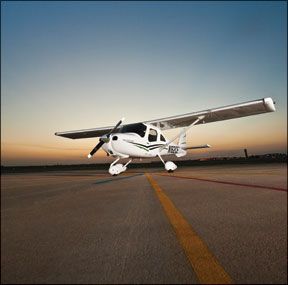In the wildly edgy television series, The Wire, there’s a classic line for a would-be challenger: “If you come at the King, you best not miss.” Somehow, that seems to apply in the light sport market as a multitude of manufacturers wait and wonder what Cessnas going to do with its Skycatcher LSA. The wait part is over and the wonder soon will be. Cessna is now poised to deliver the first of its 162 Skycatchers by the end of 2009. During 2010, it will ramp up production to begin delivering the first of more than 1000 aircraft it says are on order. We got our first look and demo flight prior to AOPA Summit at Tampa, Florida, in early November. The aircraft presented to us what Cessnas Kirby Ortega called “P1,” or the first production compliant airplane. In other words, what you see is what you get, minus some wiring harnesses left over from last-minute testing. The airplane was built in Wichita, although the entire wing assembly-complete with control surfaces-was built at Cessnas Shenyang, China, contractor. The first production version flew in China in mid-September. Impressions? The airplane is exactly what Cessna always said it would be and what LSAs are supposed to be: light, a fast climber, easy to fly, but no frills and edginess. The cockpit is as spare as a 1940s training airplane, albeit one with a Garmin glass panel and a spacious baggage compartment with a skylight.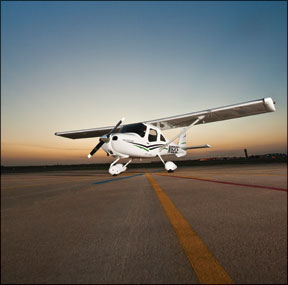
Basics
We were so expecting the Barney purple paint job Cessna sported on the prototype it showed a couple of years ago that we looked right past the Skycatcher on the ramp. In white with swooping graphics, it looks sleeker. Since the prototype appeared, Cessna has made semi-significant changes to the airframe. It dropped the pinched down wing in favor of a slightly thicker airfoil that provides more lift through the center section.
The tail has been redesigned following Cessnas much-
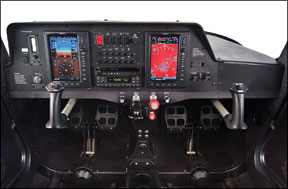
publicized loss of two test aircraft to unrecoverable spins. It added a ventral fin and changed the design for the vertical fin so its now comfortable that the airplane is recoverable from the darkest corners of the spin envelope. Nonetheless, the airplane is not approved for spins. But pilots will spin it anyway and Cessna knows that, hence the changes.
The interior follows the prototype with two exceptions: the original airplane had a floor-mounted stick, while the production version has a stick thats mounted forward of and immediately under the panel. Think of the Cirrus side controller shifted 18 inches to the right and youve got a pretty good idea, but one thats actually wrong.
The Cirrus stick requires rotation for roll command while the Skycatcher wants lateral motion, like a traditional center stick. Except it isn’t. A traditional stick has a definite arc which the hand-eye expects. If the Skycatchers stick arcs much, it feels different. We cant say better or worse, just different. More on that later.
The second interior change was in the seat pans. The prototype had carbon fiber; the production has metal pans with soft pad covers. The airplane is almost entirely of conventional riveted aluminum, but composite is used strategically, such as in the cowling, the wingtips and tailfeather trim. Workmanship on these parts seems typically Cessna. We paid close attention to the wings and control surfaces, which appeared cleanly riveted and painted.
Control actuation is by conventional cables and, in a return to
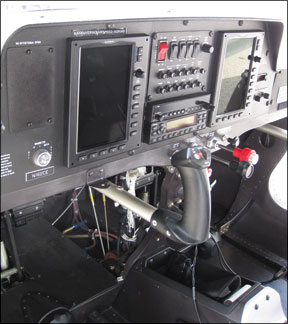
the roots of the venerable Cessna 140, the flaps are manual, via a floor-mounted brake handle. As a weight saver, no modern aircraft have steerable nosewheels these days and neither does the 162-brakes and a castoring nosewheel do the work.
The gear juts out just aft of the door centerline on tubular steel stalks that run through a box structure under the forward part of the baggage compartment. The baggage bay is huge for such a small airplane. It has a 50-pound limit and owners will have to be careful about exceeding that, given the generous volume. Its easy to get at on the ground, thanks to seats which tip forward on a pivot. The seats are low enough to allow reaching into the back to retrieve gear at the front of the baggage area.
The cabin is surprisingly wide-as wide as a Cessna 206 , according to Ortega. We didnt measure it, but we also didnt bump shoulders during our trial flight.Fore and aft, there’s legroom for those of average height, but the airplane will accommodate shorter people better than it will taller people. The seats don’t slide fore and aft-seat rails were chucked to save weight-but there is a clever knob adjustor that moves the pedals fore and aft. We were able to use this while seated in the left seat, although it does require removing the seatbelt.
The panel can best be described as spare. Its painted metal with a covered but not padded glareshield that sports an aggressive center rise to accommodate the vertical aspect of the avionics. As a result, the view out the Skycatcher forward isn’t as expansive as some other LSAs and certainly nothing like the fishbowl of the Diamond DA20.
Interior amenities are similarly minimal. There are Wemac-type vents in the wing roots, a heater, sight gauges for the fuel tanks (24 gallons usable) and the groaning stall horn thats bound to excite agita in anyone who learned to fly in a 1960s 150.
The Skycatcher is one of a handful of LSAs to sport a traditional aircraft engine, unless you consider the Rotax 912 that powers most of the LSA fleet to be so populous as to be the new traditional. The 162s Continental O-200D is the lightened version of the original engine that powered the Cessna 150. Continental scraped and bored and chipped away at it to find 30 excess pounds, but it still grinds out 100 HP. Like the original, its carbureted, so the Skycatcher has carb heat. Probing around the engine compartment, we found evidence of typical LSA lightening everywhere we looked. There’s a
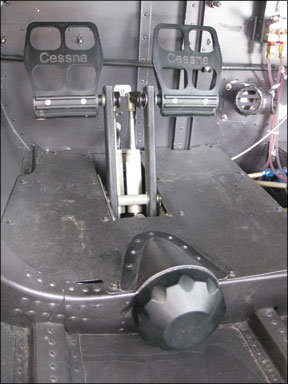
lightweight SkyTec starter, a smaller battery and alternator and a miniature version of the electrical J-box found in Cessnas larger aircraft. One thing we didnt expect were blast tubes cooling the battery and the alternator. Given the obsessive need for weight control, we asked Skycatcher program director Neal Willford why these were necessary. He said because vendors specified temperature limits and, for durability, Cessna wanted to adhere to them.
The options list for the airplane is long, but you cant have it all, due to weight limitations. The ASTM standard requires 430 pounds of useful load for a 1320-pound gross weight airplane. The example we flew had an empty weight of just shy of 850 pounds for a useful load of 478 pounds. That leaves about 40 pounds for options such as BRS (35 pounds), second MFD (2.4 pounds), wheel fairings (10 pounds) to name a few.
Flying It
Small though it is, the Skycatcher is easy to board. The doors swing up gull-wing fashion, held in place by gas springs. Just as Cessna planned, having no floor-mounted stick means you simply swing your legs inboard and strap in-no need to swing one leg over the stick, always an awkward moment for a first timer.
Start up and taxi is nothing special, although ground handling requires a touch. As is the case with many of the LSAs, the brakes felt a little stiff and unresponsive to us. The fact that the seating position is relatively low makes it more difficult to gain good purchase on the pedals.
Some LSAs have a combination of round gauges and glass, but the Skycatcher isn’t one of them. Standard equipment is the new Garmin 300, for which Cessna is the launch customer. (The G3X experimental version is similar.) A single 300 is standard, but for $4,917 more, you can have a second one on the right side to serve as a dedicated MFD.
Either way, the engine indications appear along a top band of the display, with RPMs as an electronic analog and tapes for oil pressure and temperature, plus amps. There’s also a carburetor temperature indicator, with an icing band indicated.
If you do some quick math, you discover that the Skycatcher is 280 pounds lighter (empty) than a mid-1970s Cessna 150, but with the same horsepower, so that means it should have an impressive climb rate and better cruise speed. It does. Rotation comes quickly at 50 knots indicated and, as with most of these lightweight, high-lift airplanes, it virtually levitates off the runway and climbs initially with very little deck angle.
Just off the runway at Tampa Executive, we easily managed 900 FPM at about 90 knots. Best angle requires a heroic pitch up to 58 knots, a value thats nicely (and automatically)
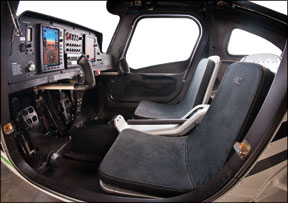
bugged on the Garmin airspeed tape.
Shortly after takeoff, we got the thing into a slight roll PIO. Thats because coming from a Cirrus, there is an inescapable urge to twist the stick at the wrist, rather than push it from the side. It has just enough to breakout force to cause a slight over control, then an over- control in the opposite direction to correct. Were not sure if this was due to control circuitry friction or the nature of the design, but other LSA types weve tried are lighter and more balanced.
On subsequent touch and goes, we didnt notice the problem, so perhaps accommodation is quick. Nonetheless, we’ll reserve judgment on this design until we get more time behind the stick. Landings require a slow glide over the numbers-like 55 knots or less. Otherwise, the airplane will float longer than a 150 ever could. These same characteristics give the 162 better short field numbers than the 150 had.
Control forces are moderate in roll and pitch and there was just enough turbulence to make judging adverse yaw futile. Stalls are gentle and because the Skycatchers elevator is up limited, the nose merely bobbles and almost self recovers while the horn does that unique groan. Stall speed is a lazy 40 knots, with full flaps. (More benefits of a light weight with a big wing, although the wing loading is a pouund higher than the 150. Power loading is 13.2 pounds/HP versus 16 pounds/HP for the 150.)
Cruise speed is similarly sprightly. We noted 115 to 118 knots at 70 percent power. Both students and instructors will appreciate this when training gets to long cross-countries during the summer.
Conclusion
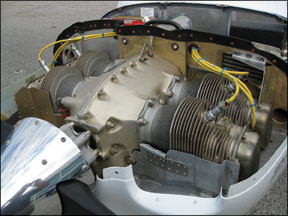
If there’s anything that passes for conventional wisdom in the world of light sport, its that Cessna would dominate when it entered the market. In our view, the Skycatcher more or less confirms this.
Lets consider the price and features first. With the single Garmin G300, TruTrak autopilot and a BRS parachute, the Skycatchers typical retail is $130,364. Similarly equipped competing LSAs such as the FlightDesign CTLS, the Tecnam Eaglet and Remos GX, are at least $10,000 more, but as much as $16,000 more. “Similarly equipped” is in the eye of the beholder here, since none of those models have the G300, but some-the Eaglet, for example-offer sophisticated glass displays that don’t happen to be made by Garmin. Buyers should compare the invoices carefully.
We suspect that other LSA manufacturers will become more price competitive in the face of the Cessna onslaught and some will simply evaporate, igniting the shakeout that everyone in the industry knows is inevitable. The Skycatcher doesnt have to be exceptionally better than any of the other LSAs and, in fact, it probably isn’t. Other LSAs may handle better, and are definitely faster and more sexy. But the Skycatcher is the bacon itself; the sizzle lies elsewhere. To dominate the market, all it has to be is competent and we’ll supported. The former seems obvious to us, the latter is an assumption that Cessna is happy to let buyers make, and more than 1000 evidently already have.

